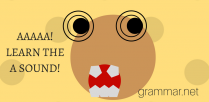Even if you do not know what adjective or adverb phrases are, you use them every day. Here is an explanation of what they are, how they work, and how to punctuate them.
To download high resolution poster click here.
Embed this image to your site:
What is an Adjective Phrase?
An adjective describes a noun (person, place, or thing) or a pronoun (he, she, it, and so forth). Adjectives cannot describe other adjectives or verbs.
“Bob’s new chicken is a friendly creature.”
“Bob,” “chicken,” and “creature” are nouns, and “new” and “friendly” are adjectives. For an example of an adjective phrase, simply add more adjectives that further describe the chicken. The new phrase functions just the same as the single adjective.
“Bob’s new chicken is a gentle, friendly, and patient creature.”
Where are Adjective Phrases Placed?
Adjectives and adjective phrases can be either before or after the noun they describe, and a sentence can have several.
“The new, white chicken is friendly and fat.”
“A big, shaggy dog is extremely loving when he is wet and muddy.”
In the latter sentence, the adjective phrases are “big, shaggy” and “wet and muddy.” Do not let the word “extremely” throw you; it is indeed a descriptive word, but it does not describe the word “dog.” “Extremely” is an adverb.
What is an Adverb Phrase?
An adjective and adverb phrase differ in that an adverb modifies verbs, adjectives, and other adverbs. To help remember the difference, the word itself has “verb” inside it, and adverbs tend to end in “-ly.” “Slowly,” “loudly,” and “happily” are all adverbs. The hard and fast rule is that an adverb cannot describe a noun: “dog” cannot be described as “extremely.”
“The dog ran joyously to me.”
This single adverb can easily be changed into an adverb phrase.
“The dog ran joyously and quickly toward me.”
“The chicken ate hungrily and quickly.”
“Swiftly and noisily, Frankie devoured his cheeseburger.”
Remember that the adverb phrase “swiftly and noisily” modifies the word “devoured” and not Frankie, himself.
Where are Adverb Phrases Placed?
Like adjective phrases, adverbs and adverb phrases can come either before or after the word they modify and are quite forgiving in their placement.
“The dog joyously and quickly ran toward me.”
“Joyously and quickly, the dog ran toward me.”
“The dog ran toward me, joyously and quickly.”
Punctuation of the Adjective and Adverb Phrase
If an adjective or adverb phrase is essential to understanding the sentence, it is called “restrictive,” and no comma is needed.
Adjective: “The football was old and dusty.”
Adverb: “Our quarterback throws swiftly and precisely.”
Say these out loud and notice the smooth flow; this can be a hint. In contrast, if there seems to be a natural pause, commas may be needed. “Nonrestrictive” phrases are not necessary to the sentence and generally require commas.
Adjective: “The football, old and dusty, flew through the air.”
Adverb: “Swiftly and precisely, the quarterback threw another touchdown.”
Say them aloud and notice the natural pauses. If a sentence is short, though, or if they would interrupt the flow, commas can sometimes be left out.
Adverbs can get hairy; just remember that the above adverb phrase does not modify the quarterback, himself. Though -ly can be a handy hint, not all of those pesky adverbs end this way. Can you think of any that do not?




![Troublesome words: affect vs. effect [infographic]](https://www.grammar.net/wp-content/uploads/2013/02/Effect-vs-affect_small-308x95.png)



